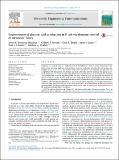Improvement of glucaric acid production in E. coli via dynamic control of metabolic fluxes
Author(s)
Stenger, Andrew R.; Gupta, Apoorv; Connors, Neal C.; Brockman Reizman, Irene M.; Reisch, Christopher R.; Prather, Kristala L. Jones; ... Show more Show less
DownloadPrather_Improvement of.pdf (1.801Mb)
PUBLISHER_CC
Publisher with Creative Commons License
Creative Commons Attribution
Terms of use
Metadata
Show full item recordAbstract
D-glucaric acid can be used as a building block for biopolymers as well as in the formulation of detergents and corrosion inhibitors. A biosynthetic route for production in Escherichia coli has been developed ( Moon et al., 2009), but previous work with the glucaric acid pathway has indicated that competition with endogenous metabolism may limit carbon flux into the pathway. Our group has recently developed an E. coli strain where phosphofructokinase (Pfk) activity can be dynamically controlled and demonstrated its use for improving yields and titers of the glucaric acid precursor myo-inositol on glucose minimal medium. In this work, we have explored the further applicability of this strain for glucaric acid production in a supplemented medium more relevant for scale-up studies, both under batch conditions and with glucose feeding via in situ enzymatic starch hydrolysis. It was found that glucaric acid titers could be improved by up to 42% with appropriately timed knockdown of Pfk activity during glucose feeding. The glucose feeding protocol could also be used for reduction of acetate production in the wild type and modified E. coli strains.
Date issued
2015-09Department
MIT Synthetic Biology Center; Massachusetts Institute of Technology. Department of Biological Engineering; Massachusetts Institute of Technology. Department of Chemical EngineeringJournal
Metabolic Engineering Communications
Publisher
Elsevier
Citation
Reizman, Irene M. Brockman, Andrew R. Stenger, Chris R. Reisch, Apoorv Gupta, Neal C. Connors, and Kristala L.J. Prather. “Improvement of Glucaric Acid Production in E. Coli via Dynamic Control of Metabolic Fluxes.” Metabolic Engineering Communications 2 (December 2015): 109–116.
Version: Final published version
ISSN
22140301